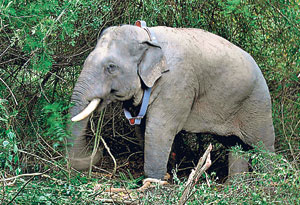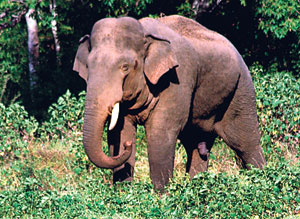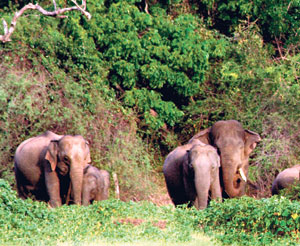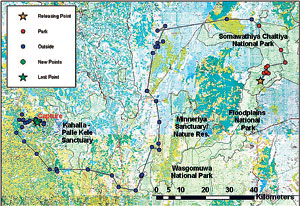Human settlements have expanded and forests have been cleared, invariably leading to conflicts not only with elephants but other wild animals as well.
As soon as there is a human-elephant conflict in some area, the traditional answer has been to “translocate” the elephant, uprooting it from its habitat and placing it in a new environment, with the expectation that it would settle down there and not cause conflict.
But is this the best answer, looking at it from both the human and elephant points of view?
This is what the Department of Wildlife Conservation (DWLC) is trying to find out, after several instances where elephants translocated many km away have come back to their very own “gama” or home, like humans who keep going back to their ancestral villages.
 |
| The collared one tusked elephant |
 |
| Near a tank |
 |
| The one-tusked elephant with a herd of elephants |
 |
Such “homecomings” have been easy to detect in recent times because some of the elephants have been “collared” by the DWLC in collaboration with the Centre for Conservation and Research.
The latest “walkabout”, however, has been by an elephant which is easily identifiable even without a radio collar as it is a majestic one-tusked adult male.
Tranquillized and captured in the Ehetuwewa divisional area in Galgamuwa on February 14 due to complaints by villagers that the elephant was creating trouble, it had been released at the Somawathiya National Park at midnight on February 15/16, 93.4 km. away in a direct line.
Translocation of an elephant is a “major operation” which needs the deployment of 20-30 people. The elephant has to be located, tranquillized by shooting with an anaesthetic dart, then tied up with thick rope and loaded on to the truck which would carry it to its new home, The Sunday Times understands.
It should also be done in the appropriate situation, so that the danger to the elephant as well as to the team capturing it is minimal, a wildlife official explained, adding that otherwise tragedies as at Elahera where a wildlife official was killed in March could happen. There, the officials had found the elephant but as daytime is not the best time to carry out such an operation had cornered it and decided to come back in the evening.
However, the villagers had in their foolishness decided to take matters into their own hands without consulting the wildlife experts and lit flares and crackers to get the elephant out of its resting place. When the wildlife team came back on hearing the commotion, the animal had charged, killing one of them.
In the case of the one-tusked elephant, the radio collar -- one of 15 purchased with funds from the Asian Development Bank -- indicates that he left the Somawathiya National Park a few days after being translocated, The Sunday Times learns.
Explaining the workings of the collar, Dr. Prithiviraj Fernando of the Centre for Conservation and Research says that it records the position of the animal eight-hourly and once in two days transmits the information to a satellite. This information can then be downloaded from a computer, the data processed and plotted on a map. This information is very valuable to the DWLC in its work.
The elephant had left the Somawathiya National Park, walked up a little towards Kantale and the border of Trikonamadu, then northwest of Kantale to the Hurulu reservoir area, gone south, crossed the Habarana junction, kept going south, turned west, crossed the Kurunegala-Dambulla Road at Galewela, walked through the lower part of the Kahalla-Pallekelle sanctuary and come back “home”. (See map)
Nearly a month and 243 km later, the one-tusked elephant is back at “home”, The Sunday Times learns.
About two weeks ago, the villagers had complained once again about this elephant which is quite used to humans and also unafraid of them. The DWLC had arrived to find the elephant in a little patch of forest in the middle of the village. It was midday and the officials were in a quandary – if they lit flares and crackers to chase it away it could charge or go in any direction and easily harm people, another wildlife source said.
But the villagers who were furious had turned on the wildlife team, the source said, adding that they mistakenly believed that the DWLC had faked the translocation and only dumped the animal at Kahalla-Pallekelle.
Why do elephants come back “home”?
Elephants, especially adult males, have a very strong attachment to their home range. They also have a very specific home range, explains Dr. Fernando, adding that not all but some come back home. Translocation is a decision taken to solve the human-elephant conflict, by looking at it from the human point of view. It is also a very costly exercise both in terms of money and human resources.
“What of the elephant,” he asks. In the past five years, experts have been looking at this issue and assessing this management action. “To solve the human-elephant conflict or mitigate it, we need to understand the elephant part of it as well. For this, we need information,” he stressed.
When translocated elephants return, they travel in the night. They also travel through areas where people may not be used to elephants. This could be dangerous to both people and elephants, The Sunday Times learns.
The one-tusked elephant had come through Galewela, which is a highly residential area and someone could have got killed if they confronted the animal, says Dr. Fernando. On the other hand, someone could also kill the elephant. This could lead to an increase in the human-elephant conflict.
What are the options in dealing with the human-elephant conflict?
According to Dr. Fernando, there are limited options. The need is to identify the biggest trouble-makers, with the first option being to translocate them at a National Park and if they persist in coming back place them in an electrically-fenced area.If that fails the only other options available are, of course, capturing the bad trouble-makers and domesticating them or in the case of inveterate trouble-makers shooting and killing them, he points out.
Dr. Fernando says that if all else fails trouble-makers can be domesticated in a scientific manner, without resorting to the traditional way of tying them up, starving them and then breaking them. “There are new ways in which horses are being tamed,” he says, recommending that Sri Lanka should look into the possibility of setting up an institution which specializes in taming wild elephants especially as they are quick and good learners.
Emphasizing that the human-elephant conflict is more of a man-made one because humans have encroached on animal territory, he explains that translocation, capture and domestication or shooting the trouble-makers are not desirable options, especially from the point of view of elephant conservation.
“They are mainly to manage the human–elephant conflict out of human necessity. Therefore, if we are considering any of these we should make sure that it is because there is no other way out and humans simply cannot live with that particular elephant,” he stresses.
Conceding that more information is needed with regard to elephant behavioural patterns, a wildlife source says it is important to identify elephant conservation areas and also reserves where elephant management can take place.
Many decisions are taken from a human angle but we need to look at the animal as well. What is best for the elephant must also be considered, the source said, adding that otherwise we will create an imbalance in our ecosystems. |




